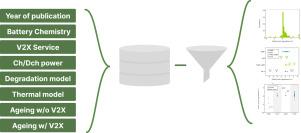V2X对电池退化的影响:定量综述
IF 7.9
2区 工程技术
Q1 CHEMISTRY, PHYSICAL
引用次数: 0
摘要
车联网(V2X)是支持能源转型的一种很有前途的解决方案,但对电池退化和容量损失的担忧仍然是电动汽车(EV)用户的主要障碍。对V2X导致的退化有一个清晰的认识,这对于增强用户信心和鼓励参与V2X服务至关重要。许多V2X研究都对电池退化进行了研究,但不同文章的研究结果差异很大,因此很难得出结论。现有的综述文章提到了不同的结果,但没有讨论其中的矛盾。在本文中,使用定量分析对大量V2X退化研究进行了比较。从37篇V2X退化论文中提取了每年因V2X而增加的退化,得出了一组97个数据点。对数据集进行分析,以比较不同情况下的退化情况,并突出相似情况下的矛盾。结果表明,年平均降解率为0.87% (95% CI: 0.35-1.4%)。当在V2X服务优化中明确考虑退化时,增加的退化被限制在每年0.9%。此外,在特定条件下,V2X甚至可以通过减少日历老化来帮助减少整体电池退化。在评估V2X对日历老化的影响时,温度和SoC尤为重要,但这些因素往往被忽视。本综述强调了V2X退化文献中影响退化影响评估的常见缺陷。研究结果可以用来澄清关于V2X退化的误解,并指导未来的研究方向。本文章由计算机程序翻译,如有差异,请以英文原文为准。

The impact of V2X on battery degradation: A quantitative review
Vehicle-to-Everything (V2X) is a promising solution to support the energy transition, but concerns about battery degradation and capacity loss remain a major barrier for electric vehicle (EV) users. A clear understanding of degradation caused by V2X is essential to increase user confidence and encourage participation in V2X services. Many V2X studies have researched battery degradation, but the results vary widely between articles, making it hard to draw conclusions. Existing review articles mention the different outcomes but do not discuss the contradictions. In this article, a large set of V2X degradation studies is compared using a quantitative analysis. The yearly added degradation due to V2X is extracted from 37 V2X degradation papers, resulting in a set of 97 data points. The dataset is analysed to compare degradation in different situations and highlight contradictions in similar situations. Results show that the average yearly added degradation is 0.87% (95% CI: 0.35–1.4%). When degradation is explicitly considered in V2X service optimisation, the added degradation is limited to just 0.9% per year. Moreover, under specific conditions, V2X can even help reduce overall battery degradation by reducing calendar ageing. Temperature and SoC are especially important in assessing the benefit of V2X on calendar ageing, but these factors are most often overlooked. This review has highlighted common shortcomings in V2X degradation literature that affect the assessment of the impact of degradation. The results can be used to clear up misconceptions about degradation in V2X and to guide future research directions.
求助全文
通过发布文献求助,成功后即可免费获取论文全文。
去求助
来源期刊

Journal of Power Sources
工程技术-电化学
CiteScore
16.40
自引率
6.50%
发文量
1249
审稿时长
36 days
期刊介绍:
The Journal of Power Sources is a publication catering to researchers and technologists interested in various aspects of the science, technology, and applications of electrochemical power sources. It covers original research and reviews on primary and secondary batteries, fuel cells, supercapacitors, and photo-electrochemical cells.
Topics considered include the research, development and applications of nanomaterials and novel componentry for these devices. Examples of applications of these electrochemical power sources include:
• Portable electronics
• Electric and Hybrid Electric Vehicles
• Uninterruptible Power Supply (UPS) systems
• Storage of renewable energy
• Satellites and deep space probes
• Boats and ships, drones and aircrafts
• Wearable energy storage systems
 求助内容:
求助内容: 应助结果提醒方式:
应助结果提醒方式:


